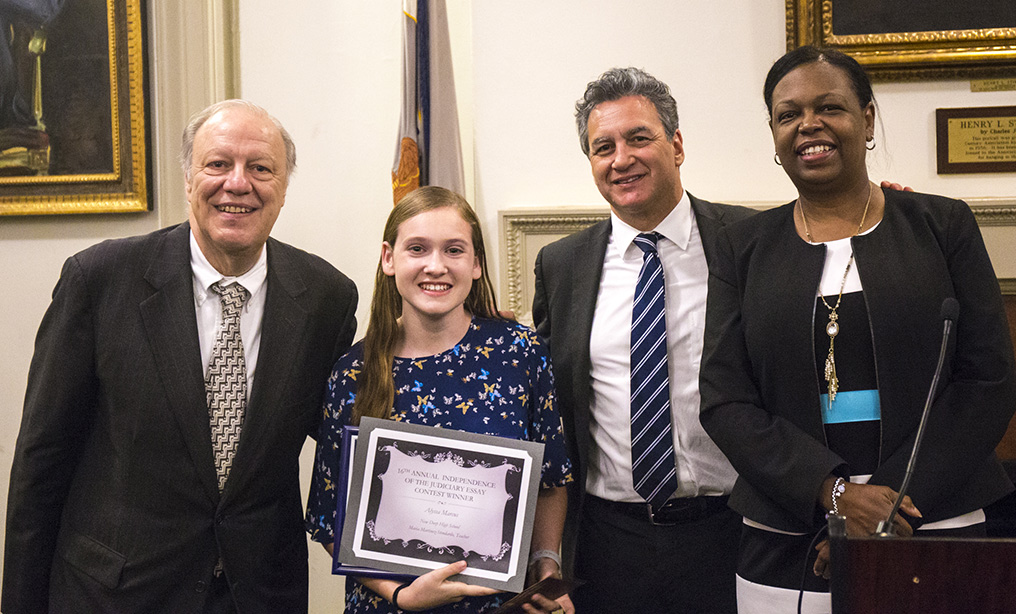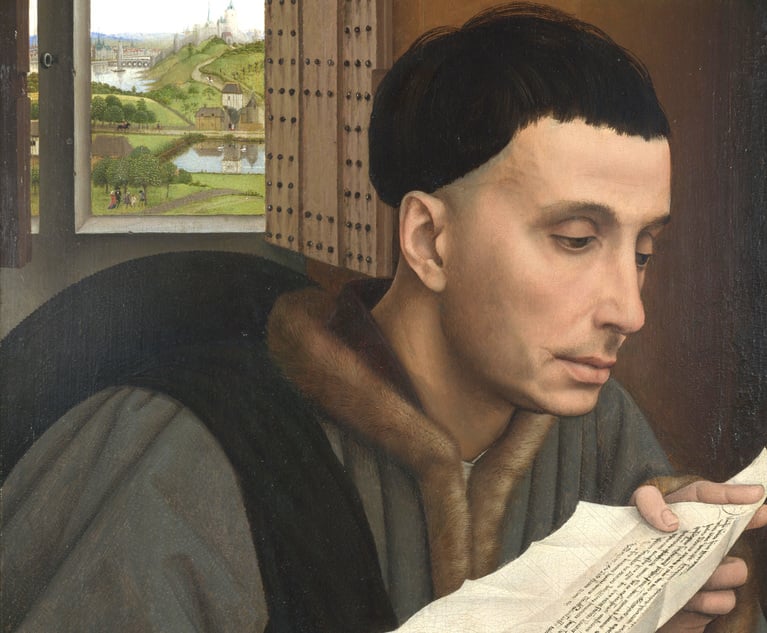Separation of Powers: Framework for Freedom
Alyssa Marcus, a junior at New Dorp High School in Staten Island, was honored Tuesday in the annual legal essay writing contest sponsored by the the Association of Justices of the Supreme Court of the State of New York and the New York Law Journal.
May 24, 2018 at 12:14 PM
5 minute read

The following is the winning essay of the Seventeenth annual High School Essay Contest sponsored by the Association of Justices of the Supreme Court of the State of New York and the New York Law Journal in partnership with the New York City Dept. of Education. The contest is open to high school students in 10th, 11th and 12th grades throughout New York City. The 2018 winner and nine finalists, who wrote on “Separation of Powers: Framework for Freedom,” will have the opportunity to intern in the state court system for one week in the summer, and were awarded gift cards from the New York Law Journal.
When the United States was first created, many factors went into building an effective government for generations to come. One of these factors included separation of powers, separating the government into three different branches in order to prevent an abuse of power. Separation of powers has a huge impact on the way the U.S. government functions.
The idea of separation of powers was first thought of by Baron de Montesquieu, a philosopher during the Enlightenment, who believed that not only should the government be separated into different branches, but that each branch should check on the other branches to ensure that no one is taking advantage of their power. This idea inspired the Founding Fathers of the United States, sparking them to include separation of powers in our United States Constitution. In 1787, the Constitution was ratified and divided into seven articles, three of which consisted of the three different branches of government.
Article I of the Constitution describes the Legislative Branch, which was created to determine how laws would be passed in the United States. This branch includes Congress, which is separated into the House of Representatives and the Senate. In order for a bill to become a law, it must first be approved by a majority of both the House of Representatives and the Senate.
Article II describes the Executive Branch, which includes the President and Vice President of the United States. In this branch, the President chooses to approve and sign bills from Congress or veto them. Likewise, this branch enforces and administers laws through the use of Federal agencies, such as police officers and the F.B.I. Additionally, Article II of the Constitution states that the President ” … shall appoint Ambassadors, other public Ministers and Consuls, Judges of the Supreme Court, and all other Officers of the United States”.
Finally, Article Ill describes the Judicial Branch and how our legal system works. This branch consists of federal courts, the Court of Appeals, and the Supreme Court. These courts interpret and apply laws to cases, and the Supreme Court has the power to declare a law unconstitutional. In fact, Article Ill, Section 2 states, “The judicial power shall extend to all cases, in law and equity, arising under this Constitution, the laws of the United States, and treaties made, or which shall be made, under their authority”.
Separation of powers gives each branch the opportunity to review the other branches to make sure a branch is not abusing of their power. In order to do this, each branch can override another branch. History has witnessed many laws in Roosevelt's New Deal be declared unconstitutional by the U.S. Supreme Court, demonstrating the Judicial Branch's power to override Congress and the President. One law declared unconstitutional was the National Industrial Recovery Act (NIRA), which granted the Executive Branch the power to regulate businesses in hopes of stimulating the economy and reducing unemployment during the Great Depression. On the other hand. The Supreme Court ruled this law unconstitutional in Schechter Poultry Corp v. United States in 1935 because the justices felt the NIRA granted law-making powers to the President that are supposed to be assigned to Congress. Furthermore, the Justice Against Sponsors of Terrorism Act (JASTA) allows victims to sue foreign governments for damages if they issued a terrorist attack on the U.S. This bill was mainly created for victims of the September 11, 2001 attack; however, Barack Obama vetoed this bill. Nonetheless, over two-thirds of both the House of Representatives and Senate approved this bill, resulting in the Justice Against Sponsors of Terrorism Act becoming a law. Evidently, our federal government is balanced out through the use of separation of powers.
The United States was built on many factors, but the foundation of it all was separation of powers. Having our government separated into three branches not only prevents a misuse or abuse of power, but also brings balance to the way our government functions. One can only imagine what our government would be like today if separation of powers was never incorporated into our Constitution.
Alyssa Marcus is a junior at New Dorp High School in Staten Island.
This content has been archived. It is available through our partners, LexisNexis® and Bloomberg Law.
To view this content, please continue to their sites.
Not a Lexis Subscriber?
Subscribe Now
Not a Bloomberg Law Subscriber?
Subscribe Now
NOT FOR REPRINT
© 2025 ALM Global, LLC, All Rights Reserved. Request academic re-use from www.copyright.com. All other uses, submit a request to [email protected]. For more information visit Asset & Logo Licensing.
You Might Like
View All
A Biblical Reconciliation Between Judaism and Islam: A Lesson for Everyone, Everywhere
6 minute readTrending Stories
Who Got The Work
J. Brugh Lower of Gibbons has entered an appearance for industrial equipment supplier Devco Corporation in a pending trademark infringement lawsuit. The suit, accusing the defendant of selling knock-off Graco products, was filed Dec. 18 in New Jersey District Court by Rivkin Radler on behalf of Graco Inc. and Graco Minnesota. The case, assigned to U.S. District Judge Zahid N. Quraishi, is 3:24-cv-11294, Graco Inc. et al v. Devco Corporation.
Who Got The Work
Rebecca Maller-Stein and Kent A. Yalowitz of Arnold & Porter Kaye Scholer have entered their appearances for Hanaco Venture Capital and its executives, Lior Prosor and David Frankel, in a pending securities lawsuit. The action, filed on Dec. 24 in New York Southern District Court by Zell, Aron & Co. on behalf of Goldeneye Advisors, accuses the defendants of negligently and fraudulently managing the plaintiff's $1 million investment. The case, assigned to U.S. District Judge Vernon S. Broderick, is 1:24-cv-09918, Goldeneye Advisors, LLC v. Hanaco Venture Capital, Ltd. et al.
Who Got The Work
Attorneys from A&O Shearman has stepped in as defense counsel for Toronto-Dominion Bank and other defendants in a pending securities class action. The suit, filed Dec. 11 in New York Southern District Court by Bleichmar Fonti & Auld, accuses the defendants of concealing the bank's 'pervasive' deficiencies in regards to its compliance with the Bank Secrecy Act and the quality of its anti-money laundering controls. The case, assigned to U.S. District Judge Arun Subramanian, is 1:24-cv-09445, Gonzalez v. The Toronto-Dominion Bank et al.
Who Got The Work
Crown Castle International, a Pennsylvania company providing shared communications infrastructure, has turned to Luke D. Wolf of Gordon Rees Scully Mansukhani to fend off a pending breach-of-contract lawsuit. The court action, filed Nov. 25 in Michigan Eastern District Court by Hooper Hathaway PC on behalf of The Town Residences LLC, accuses Crown Castle of failing to transfer approximately $30,000 in utility payments from T-Mobile in breach of a roof-top lease and assignment agreement. The case, assigned to U.S. District Judge Susan K. Declercq, is 2:24-cv-13131, The Town Residences LLC v. T-Mobile US, Inc. et al.
Who Got The Work
Wilfred P. Coronato and Daniel M. Schwartz of McCarter & English have stepped in as defense counsel to Electrolux Home Products Inc. in a pending product liability lawsuit. The court action, filed Nov. 26 in New York Eastern District Court by Poulos Lopiccolo PC and Nagel Rice LLP on behalf of David Stern, alleges that the defendant's refrigerators’ drawers and shelving repeatedly break and fall apart within months after purchase. The case, assigned to U.S. District Judge Joan M. Azrack, is 2:24-cv-08204, Stern v. Electrolux Home Products, Inc.
Featured Firms
Law Offices of Gary Martin Hays & Associates, P.C.
(470) 294-1674
Law Offices of Mark E. Salomone
(857) 444-6468
Smith & Hassler
(713) 739-1250









